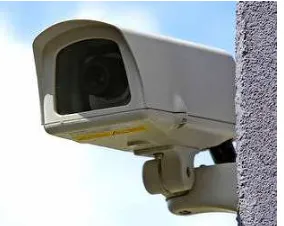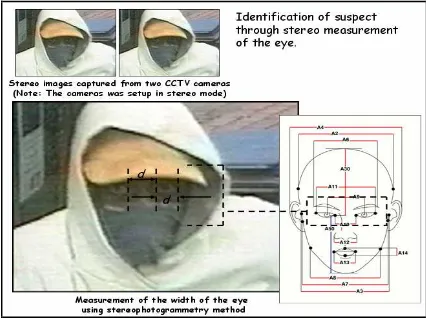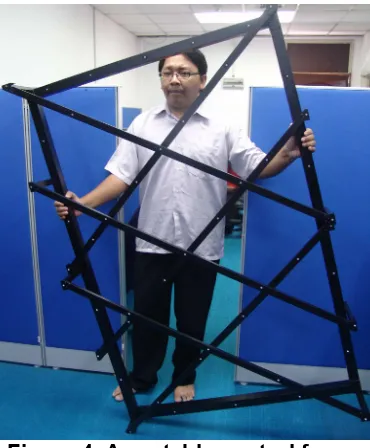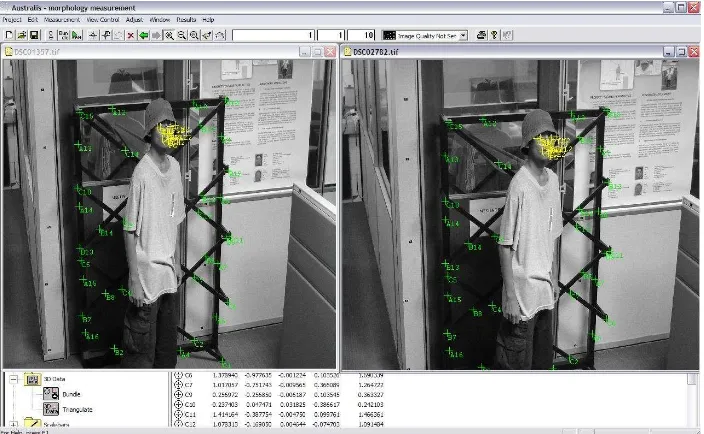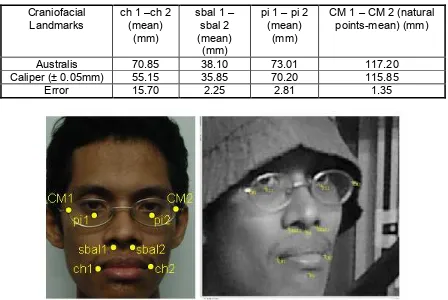PHOTOGRAMMETRIC-BASED SECURITY SYSTEM
Mohd Farid Mohd Ariff1, Zulkepli Majid1, Albert K. Chong2 and Halim Setan1 1
UTM-Photogrammetry and Laser Scanning Research Group , Universiti Teknologi Malaysia 2
Faculty of Engineering and Surveying, University of Southern Queensland E-mail: zulkeplimajid@utm.my
ABSTRACT
The paper discusses the new approach to detect criminal suspect through camera images with the integration of surveillance camera system and close-range photogrammetric technique. The setting up of the surveillance camera system is based on the stereo photogrammetric mode. For high accuracy photogrammetric measurement, the space which was covered in the surveillance cameras field of view (FOV) was calibrated using special-built portable high precision control frame. Via close-range photogrammetry technique, the physical morphology (example: anthropometry of facial features) of the suspect can be measured accurately.
Keywords: Photogrammetry, Security, Forensic, Surveillance Camera
1.0
INTRODUCTION
[image:1.612.238.380.491.604.2]Recently, most of the surveillance work has been done in a 2D environment. In most existing systems, a single camera is used to observe an area (Figure 1). Using 2D techniques it is very hard to resolve occlusions and track multiple people, whereas 3D techniques can take care of the occlusion problem and can distinguish multiple objects from the scene quite accurately (Mishraet.al, 2007).
Figure 1. Camera surveillance system (setup in mono mode)
gave four techniques: (i) direct ratio, (ii) ray tracing, (iii) resection, and (iv) reverse perspective analysis. Direct ratio used the dimensions of objects near the crime suspect to determine the height of the suspect. The other three techniques required more sophisticated construction of light rays, which needed special skills to interpret the measurement.
The 3D (stereo-image) camera system provides the capabilities of suspect identification in three-dimensional environment. Using stereophotogrammetric concepts, the physical behavior of the suspect can be identified and visualized accurately. With the stereo-images captured by the 3D camera system, the measurement of suspect morphology can be carried out based on human body anthropometric knowledge (examples: height, facial anthropometry and etc) (Figure 2). The measurement results provide high accuracy forensic evidences for suspect identification.
[image:2.612.199.412.312.471.2]For high accuracy measurement, the image refinement process needs to be applying to the captured stereo images. The refinement process was based on the camera calibration parameters which include the corrected focal length, principal point coordinates, radial lens distortions and tangential lens distortions.
Figure 2. The measurement of suspect morphology based on human body anthropometric concepts
The purpose of this paper is to introduce a new approach for the computation technique using stereo-image of surveillance images to provide accurate measurement of the physical features of the crime suspect. The paper includes detail discussion of the in situ camera lens calibration and the analysis of the forensic measurements results.
2.0
METHODOLOGY
2.1
In Situ Surveillance Camera Lens Calibration
Figure 3. Sony DSC F828 (stereo mode)
For the calibration purposes, each sensor was calibrated simultaneously. A camera lens calibration was carried out using Australis, state-of-the-art bundle software, developed at the University of Melbourne, Australia and using a high accuracy calibration testfield (a portable control frame).
2.1.1
A Portable Control Frame
[image:3.612.214.399.428.652.2]Figure 4 shows a portable control frame that used in the research. Retro-targets were placed on the frame and on the bracing at three level of depth (0-mm, 75-mm & 150-mm). Retro-targets are highly reflective targets, which are specially made for precise automated digitizing using computer software (Atkinson, 1996). The coordinates of the retro-targets on the control frame were obtained photogrammetrically. The frame was placed over multi-purpose camera calibration range and a set of six convergent digital images was taken with a Sony DSC F828. A bundle adjustment was carried out using the Australis photogrammetric bundle adjustment software. The root mean square (RMS) values of the computed coordinates were 0.11, 0.09 and 0.13 in the x, y and z-axes, respectively. The mathematics of RMS computation is provided in Slama (1980).
Figure 4. A portable control frame
was used to level the control frame. Leveling the frame reduced the kappa rotation (or rotation along the Z-axis) and the omega rotation (or rotation along the X-axis) to a minimum.
2.1.2
Camera Lens Calibration
The cameras were mounted on a platform, which was anchored to a wall at 2.5 above the lab floor. The cameras lens focus was set at infinity. An object distance of 3.0-m was selected for the calibration (similar distance was measured between the cameras and the crime suspect). Convergent imagery of the portable control frame was taken by tilting the control frame through four different rotations (Karara, 1989). These rotations simulated a set of four convergent image of the set-up for each camera. Each set-up was repeated three times.
2.2
Case Study
[image:4.612.131.483.327.544.2]To the test developed technique rigorously, it was necessary to set up tests in a laboratory prior to introducing the technique onto crime scene. The camera position was the same as that discussed in the previous section. A suspect was set up at a short distance in front of a portable control frame as depicted in Figure 5. The suspect represented the crime suspect in the test.
Figure 5. A suspect was set up at a short distance in front of a portable control frame
3.0
RESULTS AND DISCUSSION
3.1
Camera Calibration
Table 1. Camera calibration results
Parameters Camera ID
c
p
x
y
pk
1k
2k
3Sony 01 7.423 -0.123 -0.018 3.1x10-3 -2.3x10-5 -5.2x10-7
Sony 02 7.412 -0.145 0.020 3.1x10-3 -2.3x10-5 -6.3x10-7
3.2
Anthropometric Measurements
[image:5.612.83.531.402.702.2]Only preliminary results are availably in this section. The stereo-images of suspect were measured using Australis software. The measurements are based on anthropometry human face (craniofacial landmarks). Recent publications such as D’Apuzzo (2003) and Majid et.al. (2005) showed that photogrammetry is the most suitable method for capturing anthropometric landmarks. Standard (traditional) methods to measure anthropometric landmarks are using tools such as sliding calipers or digital calipers (Kolar and Salter, 1997).
Table 2 shows the results of measurement between Australis software and caliper. A few points are measured (Figure 6) and each measurement was repeated three times. For analysis, the comparisons are based on the distance value (straight measurement).
Table 2. Anthropometric measurement (Australis vs. caliper)
Craniofacial Landmarks
ch 1 –ch 2 (mean)
(mm)
sbal 1 – sbal 2 (mean)
(mm)
pi 1 – pi 2 (mean)
(mm)
CM 1 – CM 2 (natural points-mean) (mm)
Australis 70.85 38.10 73.01 117.20 Caliper (± 0.05mm) 55.15 35.85 70.20 115.85 Error 15.70 2.25 2.81 1.35
Based on Table 2, the errors for every set of data (sbal1–sbal2; pi1-pi2; CM1-CM2) are below 3.0-mm, except the measurements for (ch1-ch2) provides error more than 10-mm. The errors cause by few factors such as; manual digitizing, difficulty of identifying craniofacial landmarks, suspect face impression and other factors.
4.0
CONCLUSIONS
With the stereo-images captured by the 3D camera system, the measurement of suspect morphology can be carried out based on human body anthropometric concepts. The measurement can provide high accuracy forensic measurements for suspect identification. Based on the results, we found that there could be a few important factors which could reduce the accuracy of anthropometric measurement data. Consequently these factors were studied in more detail and the results show that accuracy could be degraded considerably.
For further research, stereo camera will be replaced with the combination of one high definition (HD) video and stereo adapter. High definition video will be provided high details video (image), while the stereo adapter will be used in order to provide a true Stereoscopic 3D image (stereo images). More research is needed to improve the technique in order to achieve optimum photogrammetric measurement. Certainly, there is potential for sterophotogrammetric techniques for forensic measurement of surveillance images.
ACKNOWLEDGEMENT
The author acknowledges financial assistance for this research from Ministry of Science, Technology and Innovation (MOSTI) for Scholarship of Postgraduate Fellowship Scheme (PGD) and e-science fund vote 79141.
REFERENCES
Atkinson, K.B. (Ed)., 1996. Close Range Photogrammetry and Machine Vision. Whittles Publishing, Caithness, Scotland, 371 pages.
Chong, A.K., 2002. A Rigorous Technique for Forensic Measurement of Surveillance Video Footage. Photogrammetric Engineering & Remote Sensing, Vol. 68, No.7, July 2002.
D’Apuzzo, N., 2002. Surface Measurement and Tracking of Human Body Parts From Multi Station Video Sequences. Institute Geodesy and Photogrammetry, ETH Honggerbergh, Zurich. Dissertation No. 15271. 161 pages.
Fryer, J.G., 2000. Drawing the Line on Criminals: Forensic Photogrammetry Made Simple.
Engineering Surveying, GITC Publishing, Lemmer, the Netherlands.
Klasen, L., and O. Fahlender., 1997. Using Videogrammetry and 3D Image Reconstruction to Identify Crime Suspects. Investigative Image Processing, Proceedings of SPIE. Vol. 2942, 162 (1997);
Kolar, C. And Salter, E.M., 1997. Craniofacial Antrophometry: Practical Measurement of the Head and Face for Clinical, Surgical and Research Use. Charles C. Thomas, Springfield, Illinois, 334 pages.
Majid, Z., Chong, A.K., Ahmad, A., Setan, H. and Samsudin, A.R., 2005. Photogrammetry and 3D Laser Scanning as Spatial Data Capture Techniques for a National Craniofacial Database.
Photogrammetric Record, 20 (109): 48-68.
Mishra, A.K., Ni, B., Winkler, S. and Kassim, A., 2007. 3D Surveillance System Using Multiple Cameras. Department of Electrical and Computer Engineering, National University of
Singapore, Singapore.
Proesman, M., Luc, V.G. and Filip, D., 1997. Recognition of Suspects Through 3D Photographs. Investigative Image Processing, Proceedings of SPIE, Vol. 2942, p. 170-181.
Richards, G.B., 1984. The FBI Laboratory’s Past, Present and Potential Application of
Photogrammetry. Proceedings of ASPRS Fall Convention 1984, 09-14 September, Forth Worth, Texas, pp. 645-651.
Slama, C., 1980. Manual of Photogrammetry. Fourth Edition, American Society for Photogrammetry and Remote Sensing, Falls Church, Virginia.
Whitnall, J., 1984. Unimpeachable witness: The grid, Proceedings of 607. ASPRS Fall Convention of 1984, 09-14 September, Fort Worth, Texas, pp. 652-661.
Whitnall, J. And Moffitt, F.H., 1989. Forensic Photogrammetry. In: Non-topographic
Photogrammetry, Second Edition. (Ed. Karara , H.M.), American Society for Photogrammetry and Remote Sensing, Falls Church, Virgina, pp. 389-393.
Williamson, J.R. and Brill, M.H., 1990. Dimensional Analysis Through Perspective. Kendall/Hunt Publishing Co, Dubuque, Lowa, 350 pages.
AUTHORS
degree from Universiti Teknologi Malaysia, Malaysia. His PhD research lies in the area of Photogrammetry for Forensic Applications.
Dr. Zulkepli Majid is a senior lecturer at the Faculty of Geoinformation Science & Engineering,Universiti Teknologi Malaysia. Currently, he is the head of Photogrammetry and Laser Scanning Research Group. He holds BSc.(Land Surveying) degree, M.Sc (Photogrammetry) degree and a PhD (Medical Photogrammetry) degree from Universiti Teknologi Malaysia, Malaysia. His research interests lie in the areas of Photogrammetry and Laser Scanning for various applications. His current research projects are the application of photogrammetry in forensic and assets data capture using terrestrial laser scanner.
Dr. Albert K. Chong is a senior lecturer at the Faculty of Engineering and Surveying, University of Southern Queensland. He holds B.Sc in Photogrammetry from California State University, Fresno, M.Sc. (Civil Engineering) from the University of Washington and a PhD (Civil Engineering) from The university of Washington. His research interests lie in the areas of close-range photogrammetry and close-range laser scanning. He has authored over 137 articles in both international and national refereed journals, conference proceedings, and workshop in field of engineering, surveying, photogrammetry, laser scanning and GPS.
